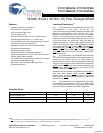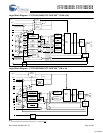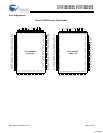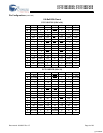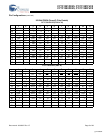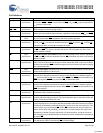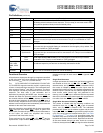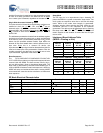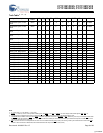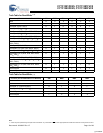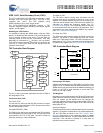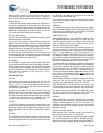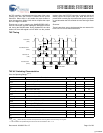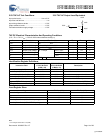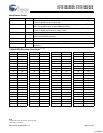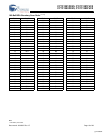
CY7C1381DV25, CY7C1381FV25
CY7C1383DV25, CY7C1383FV25
Document #: 38-05547 Rev. *E Page 7 of 28
Functional Overview
All synchronous inputs pass through input registers controlled
by the rising edge of the clock. Maximum access delay from
the clock rise (t
CDV
) is 6.5 ns (133 MHz device).
The CY7C1381DV25/CY7C1383DV25/CY7C1381FV25/
CY7C1383FV25 supports secondary cache in systems using
a linear or interleaved burst sequence. The interleaved burst
order supports Pentium
®
and i486™ processors. The linear
burst sequence is suited for processors that use a linear burst
sequence. The burst order is user selectable, and is
determined by sampling the MODE input. Accesses can be
initiated with either the processor address strobe (ADSP
) or
the controller address strobe (ADSC
). Address advancement
through the burst sequence is controlled by the ADV
input. A
two-bit on-chip wraparound burst counter captures the first
address in a burst sequence and automatically increments the
address for the rest of the burst access.
Byte write operations are qualified with the byte write enable
(BWE
) and byte write select (BW
X
) inputs. A global write
enable (GW) overrides all byte write inputs and writes data to
all four bytes. All writes are simplified with on-chip
synchronous self timed write circuitry.
Three synchronous chip selects (CE
1
, CE
2
, CE
3
[2]
) and an
asynchronous output enable (OE
) provide for easy bank
selection and output tri-state control. ADSP is ignored if CE
1
is HIGH.
Single Read Accesses
A single read access is initiated when the following conditions
are satisfied at clock rise: (1) CE
1
, CE
2
, and CE
3
[2]
are all
asserted active, and (2) ADSP
or ADSC is asserted LOW (if
the access is initiated by ADSC
, the write inputs must be
deserted during this first cycle). The address presented to the
address inputs is latched into the address register and the
burst counter and/or control logic, and presented to the
memory core. If the OE
input is asserted LOW, the requested
data will be available at the data outputs with a maximum to
t
CDV
after clock rise. ADSP is ignored if CE
1
is HIGH.
Single Write Accesses Initiated by ADSP
This access is initiated when the following conditions are
satisfied at clock rise: (1) CE
1
, CE
2
, CE
3
[2]
are all asserted
active, and (2) ADSP
is asserted LOW. The addresses
presented are loaded into the address register and the burst
inputs (GW
, BWE, and BWX) are ignored during this first clock
cycle. If the write inputs are asserted active (see Truth Table
for Read/Write
[4, 9]
on page 10 for appropriate states that
indicate a write) on the next clock rise, the appropriate data will
be latched and written into the device. Byte writes are allowed.
All IOs are tri-stated during a byte write. As this is a common
IO device, the asynchronous OE
input signal must be deserted
MODE Input-Static Selects burst order. When tied to GND selects linear burst sequence. When tied to V
DD
or
left floating selects interleaved burst sequence. This is a strap pin and must remain static
during device operation. Mode pin has an internal pull up.
V
DD
Power Supply Power supply inputs to the core of the device.
V
DDQ
IO Power Supply Power supply for the IO circuitry.
V
SS
Ground Ground for the core of the device.
V
SSQ
IO Ground Ground for the IO circuitry.
TDO JTAG serial output
Synchronous
Serial data-out to the JTAG circuit. Delivers data on the negative edge of TCK. If the JTAG
feature is not used, this pin can be left unconnected. This pin is not available on TQFP
packages.
TDI JTAG serial input
Synchronous
Serial data-in to the JTAG circuit. Sampled on the rising edge of TCK. If the JTAG feature
is not used, this pin can be left floating or connected to V
DD
through a pull up resistor. This
pin is not available on TQFP packages.
TMS JTAG serial input
Synchronous
Serial data-in to the JTAG circuit. Sampled on the rising edge of TCK. If the JTAG feature
is not used, this pin can be disconnected or connected to V
DD
. This pin is not available on
TQFP packages.
TCK JTAG-
Clock
Clock input to the JTAG circuitry. If the JTAG feature is not used, this pin must be
connected to V
SS
. This pin is not available on TQFP packages.
NC, NC/(36M,
72M, 144M,
288M, 576M,
1G)
- No Connects. Not internally connected to the die. 36M, 72M, 144M, 288M, 576M, and 1G
are address expansion pins and are not internally connected to the die.
V
SS
/DNU Ground/DNU This pin can be connected to ground or can be left floating.
Pin Definitions (continued)
Name IO Description
[+] Feedback



